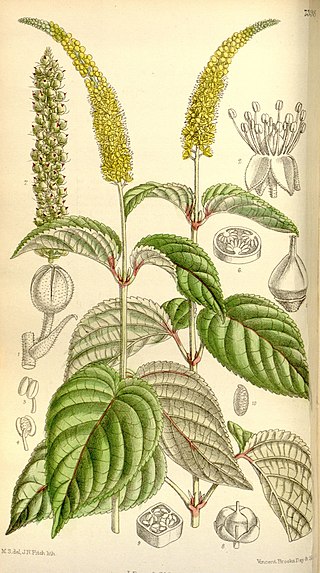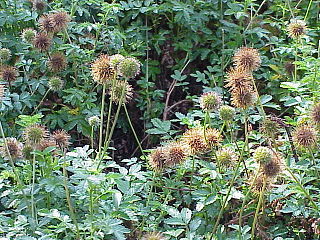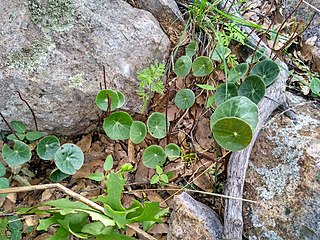
Peperomia is one of the two large genera of the family Piperaceae. It is estimated that there are at least over 1,000 species, occurring in all tropical and subtropical regions of the world. They are concentrated in South and Central America, but may also be found in southern North America, the Caribbean islands, Africa, Oceania, and southern and eastern parts of Asia. The exact number of species is difficult to determine, as some plants have been recorded several times with different names, and new species continue to be discovered. Peperomias have adapted to many different environments and their appearances vary greatly. Some are epiphytes or lithophytes, and many are xerophytes or possess underground tubers (geophytes). Most species are compact perennial shrubs or vines.

Stipa is a genus of around 300 large perennial hermaphroditic grasses collectively known as feather grass, needle grass, and spear grass. They are placed in the subfamily Pooideae and the tribe Stipeae, which also contains many species formerly assigned to Stipa, which have since been reclassified into new genera.

Abatia is a genus of about ten species of Central and South American trees in the family Salicaceae. Previously, it was treated in the family Flacourtiaceae, or tribe Abatieae of the family Passifloraceae or Samydaceae by G. Bentham & J.D. Hooker and Hutchinson.

Anthericum is a genus of about 65 species, rhizomatous perennial plants in the family Asparagaceae, subfamily Agavoideae. It was formerly placed in its own family, Anthericaceae. The species have rhizomatous or tuberous roots, long narrow leaves and branched stems carrying starry white flowers. The members of this genus occur mainly in the tropics and southern Africa and Madagascar, but are also represented in Europe.

Acaena is a genus of about 60 species of mainly evergreen, creeping herbaceous perennial plants and subshrubs in the family Rosaceae, native mainly to the Southern Hemisphere, notably New Zealand, Australia and South America, but with a few species extending into the Northern Hemisphere, north to Hawaii and California.

Azara is a genus of eleven species of flowering plants in the family Salicaceae. They are native to temperate to subtropical regions of South America, from southern Brazil and Bolivia to southern Argentina and Chile. They are most often found at woodland margins and lakesides. Azara was formerly classed in the family Flacourtiaceae.

Talinum is a genus of herbaceous succulent plants in the family Talinaceae whose common names include fameflower. It includes 27 species native to tropical and subtropical regions of the Americas, sub-Saharan Africa, the Arabian Peninsula, Indian subcontinent, and Myanmar. Several species bear edible leaves, and Talinum fruticosum is widely grown in tropical regions as a leaf vegetable. Talinum paniculatum is grown as an ornamental plant.

Heteranthera is a genus of aquatic plants in the water hyacinth family, Pontederiaceae, known generally as mud plantains. Species of this genus are native to tropical and subtropical America and Africa. They live in the water or in wet soils. They produce leaves on long petioles and some are cultivated for their attractive flowers. Leaves are of two types - linear and submerged or orbicular and floating. Some species have cleistogamic flowers.

John Lindley published Epidendrum subg. Spathium of the Orchidaceae. According to Lindley's diagnosis, the E. subg. Spathium is recognizable by is sympodial habit with individual stems being slender and covered by the bases of the distichous leaves, by the lip of the flower being adnate to the column to its apex, and by the inflorescence emerging from at least one spathe, similar to nearly all members of the genus Cattleya as understood in the year 2000. Reichenbach recognized 52 species in this subgenus, of which Kew accepts 48 :

Tillandsia virescens is a species of flowering plant in the family Bromeliaceae. This species is native to Argentina, Bolivia, Chile and Peru. It was first described in 1802.

Carludovica palmata is a species of flowering plant in the family Cyclanthaceae. It is not a true palm, but its leaves are very similar compared to the leaves of some true palms, for example, to Chelyocarpus ulei. Unlike several true palms, C. palmata does not develop a woody trunk. Its female flowers have large stigmas, and its male flowers have a lot of pollen.
Peperomia macrorhiza is a species of plant in the genus Peperomia. It is endemic to Peru. It is a geophytic plant, storing water and reserves in an underground tuber. During dry periods parts above ground, such as leaves, will wither away but the plant will survive due to the tuber. When more rain falls the plant regrows its stalks and leaves on the surface.
Peperomia peruviana is a species of flowering plant in the genus Peperomia. Its native range is in South America from Colombia to northern Argentina.

Peperomia inaequalifoliais a species of flowering plant in the family Piperaceae. Its native range covers Colombia and Peru, where it grows in tropical and subtropical forests. The plant typically has thick, fleshy leaves and is often found growing as an epiphyte, clinging to trees in humid environments. Like other species in the genus, it is sometimes cultivated as a decorative houseplant due to its attractive foliage and ability to thrive in low-light conditions.

Peperomia bracteata is a species of plant in the genus Peperomia. Its native range covers Mexico and Guatemala. It is a geophytic plant, storing water and reserves in an underground tuber. During dry periods parts above ground, such as leaves, will wither away but the plant will survive due to the tuber. When more rain falls the plant regrows its stalks and leaves on the surface.

Peperomia monticola is a species of plant in the genus Peperomia. It is endemic to Mexico. It is a geophytic plant, storing water and reserves in an underground tuber. During dry periods, parts above ground, such as leaves, will wither away but the plant will survive due to the tuber. When more rain falls, the plant regrows its stalks and leaves on the surface.
Peperomia acuminata, is a species of flowering plant in the family Piperaceae. Its native range reaches from central South America to Central America and the West Indies.

Peperomia tetragona is a species of flowering plant in the family Piperaceae. It is native to South America with a range from Ecuador, Peru, and Paraguay to central/western Brazil. Long grown as a houseplant in temperate climates, it is often known by its synonym Peperomia puteolata or as the parallel Peperomia for the parallel venation on its elliptical leaves.
Peperomia vellarimalica is a species of plant from the genus 'Peperomia'. It grows in wet tropical biomes. It was discovered by Jose Mathew and Pichan Salim in 2018. They named it after a nearby Mountain Range in Kerala, India.














